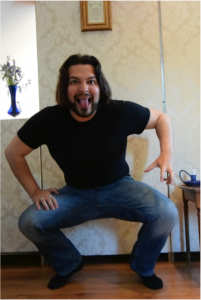Naturally, when tackling the process of putting on a medieval drama in the midst of fast-paced twenty-first century life, one ongoing question underlies the entire rehearsal and preparation process: how much of the “medieval” do we attempt to preserve, and to what degree is it necessary to impose our inherent modern perspectives on the text? This question has stimulated many a healthy debate amongst those involved in the preparation and production of The Play of Adam, and for the actors, it has meant making very intentional choices inspired by research.
After character parts were assigned following auditions, Francisca Stangel, our director, urged the actors to research medieval images (twelfth-century when possible) that would inspire movement and posture choices for various situations throughout the play. Each actor brought a small collection of images to the following rehearsal and paired a portion of the text (or a specific situation within the play) with movements that each image inspired. The exercise produced some fascinating results, and the experiment forced the cast to explore various possibilities, no matter how contrived or outdated the movements might feel. In this way, the cast fought together to establish a strong link between the present and the medieval past as a foundation for the weeks of rehearsals yet to come.

Excerpt from God and Lucifer
British Library Royal 2 B VII
(‘The Queen Mary Psalter’)
England, between 1310 and 1320
On the other hand, the text itself is startlingly modern. Originally performed in medieval French vernacular—itself a unique trait for its time, with selected parts of the script in Latin (stage directions and biblical quotations or paraphrases), the fabulous translation by Carol Symes retains the strikingly innovative feel of the play as a whole. Sentences like “what’s up, Adam,” initially cause the reader to question the quality of the translation, but after examining the original French (the play is helpfully organized as a split-page translation), which reads, “Que fais, Adam,” one realizes that much of the text originally read as a casual conversation.
However, the story surrounding the heart-wrenching fall of man is anything but casual; similarly, the text alternates between rhyming octosyllabic couplets that make up the more conversational (and often quite humorous) dialogue between characters and ten-syllable lines organized into rhyming quatrains that communicate a far more serious, solemn, or stately intent. For instance, some of God’s monologues are organized in the latter fashion, as are Adam and Eve’s laments following the fall. These passages contain an inherently serious undertone that is not as evident in the rapid-fire dialogue between characters elsewhere in the text. For example, in contrast to many of the lengthy monologues, most of Satan’s dialogue—which is quite fast-paced and clever—is organized into rhyming octosyllabic couplets with both humorous and dark undertones.
This organization of the text is hardly surprising, as medieval thought in general reveled in contrast and dichotomy. Indeed, the play is both humorous and serious; does not (or should not) great humor always have a serious undertone or intent? This is the brilliance, among many other fascinating elements, of Ordo representacionis Ade (The Play of Adam). If actors, props, scenery, costumes, and music were stripped away, the text would still speak for itself: the medieval and modern mingle quite clearly on the page.
Thus, in keeping with the text itself, and with a work-in-progress performance a mere week away, the actors have come to terms with the fact that it is impossible to entirely choose one over the other; it is necessary that medieval and modern mingle in Paradise.
— Grace Grussenmeyer
